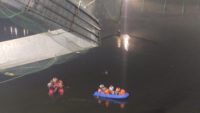Work has begun to demolish what remains of the rail bridge that collapsed June 24 in Reed Point, Mont. and remove 10 railcars carrying hazardous chemicals that fell into the Yellowstone River.
The U.S. Environmental Protection Agency said the derailment affected a total of 55 railcars crossing the railroad portion of Yellowstone Twin River Bridges bridge when it collapsed. The ten that landed in the river contain sodium hydrosulfide, asphalt liquified petroleum and molten sulfur, said EPA. The quantity of the contents in the rail cars varies but is typically in the thousands of gallons, it said. The Associated Press reported that officials shut down drinking water intakes downstream while they evaluated the danger after the early morning incident.
Officials are unsure of what caused the collapse that destroyed the bridges' railroad portion.
The entity set up by state and local officials to manage and direct the response to the incident, known as Unified Command, reported June 27 that crews had arrived to begin dismantling the bridge and removing the railcars. After disassembling the west segment of the bridge, crews used riprap to construct a causeway. The next steps will focus on removing the remaining tank cars.
The Unified Command team comprises representatives from Stillwater County Disaster and Emergency Services, the Montana Dept. of Environmental Quality, EPA and Montana Rail Link.
In an earlier update, Unified Command stated that contents of both railcars that carried sodium hydrosulfide had been successfully transferred into stable railcars and moved to safety. Crews also had removed those containing fertilizer and one car carrying asphalt, leaving four asphalt cars remaining on the eastern side of the bridge to be removed. Of the cars that fell into the river—six contained asphalt, three contained molten sulfur and one contained scrap metal. Two cars were submerged.
Unified Command said asphalt globules have been detected downstream on the banks and in the body of the river. While this solid waste is not water soluble and not expected to impact water quality, the team states that samples will continue to be taken and analyzed. "At this time, there are no known risks to public drinking water or private drinking water wells," it said.
The team said Whitewater Rescue Institute in Missoula, Mont., is assisting with river assessment and safety protection. It has eight boats currently deployed, with six working to identify the downstream extent of the material release.
Rail bridge owners are responsible for its inspection and maintenance, officials said, with a copy of recent bridge inspection reports requested.
A deteriorated highway bridge that ran parallel to the same section of the Yellowstone River between Reed Point and Columbus was closed for repairs in 2021. According to local media reports at the time, a concrete pier supporting it had been so eroded by water and debris flow over its 90-year lifespan that the Montana Dept. of Transportation determined it was in imminent danger of collapsing into the river. It said the pier needed to be demolished and rebuilt.
The area also received historic levels of rainfall last summer that led to record flooding. Yanling Leng, chief bridge engineer at civil and structural engineering firm IMEG Corp., says an estimated 60% of all bridge failures result from scour—the removal of sediment such as sand and gravel from around bridge abutments or piers. Fast-flowing water can carve out scour holes, compromising the structure’s integrity, which she says is not easy to detect because it’s happening underwater. “To do an inspection you have to actually be in the water,” Leng adds.
Coldwater Engineering, Helena, Mont., was tasked with the rehabilitation work to prolong the life of the Twin Bridges road span piers and with floodplain and environmental permitting work in the area. A firm representative declined to comment to ENR.
The text of this article was updated on June 27 to reflect new information.





Post a comment to this article
Report Abusive Comment